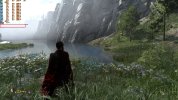You are using an out of date browser. It may not display this or other websites correctly.
You should upgrade or use an alternative browser.
You should upgrade or use an alternative browser.
Next-Generation NVMe SSD and I/O Technology [PC, PS5, XBSX|S]
- Thread starter Shortbread
- Start date
To add a little more about 870 ssd.
I also have a 980 pro and i see no difference between the two.
From desktop it takes ~20s to load a save (hammering b to skip logos)
I also have a 980 pro and i see no difference between the two.
From desktop it takes ~20s to load a save (hammering b to skip logos)
Without edit capability it will be hard for me. fixed :
I also have a 980 pro and i see no difference between the two.
DavidGraham
Veteran
This is different, look at the screenshots DSO provided, their frametime graph is a flat line (or with far less spikes) in the case of the SSD, however it's full of spikes and stutters in the NVMe shot, and this is happening during actual still shots of gameplay moments, no loading screens or black screens are involved.If CapFrameX is right this is a mesureament problem. The performance stay the same.
I have a 3070.
Honestly, yes. I might even end up selling it and getting a 3060 instead. I really have no quarrels with playing games at 30-40 frames. I could even get some cash on top of it. I just want high quality textures.
But I hoped that with new gen tech, VRAM amounts would only be a miniscule detail. Sampler feedback streaming, DirectStorage and all that jazz made me hopeful that intelligent use of a 8 GB buffer could enable nextgen graphics with increased texture fidelity.
If Hogwart Legacy and Starfield ends up the same way, I'm done with this card. I could even downgrade to 3060 if it needs be. Or maybe sidegrade to a 6700xt/6750xt.
From an RT point of view the 12GB RTX3060 will easily see PS5 GPU's off.
Its not really a showcase for good programmed games... its running horrible on the PS5 aswell. Back to 720/20fps there.... damn. 3060 is very close in raster, probably depending on game they trade blows, faster in RT and supports hw ML/AI reconstruction. Also larger dedicated vram buffer.
davis.anthony
Veteran
Using Rivatuna statistics server to cap the framerate to 60fps gave me a perfect flatline and the game felt amazingly smooth.
I also only saw texture issues after a small cutscene where I opened a chest, the 10 minutes running around before that didn;t have a single issue with texture glitching or using low resolution textures.
I have the game installed on a SATA III SSD.
I also only saw texture issues after a small cutscene where I opened a chest, the 10 minutes running around before that didn;t have a single issue with texture glitching or using low resolution textures.
I have the game installed on a SATA III SSD.
Attachments
This is different, look at the screenshots DSO provided, their frametime graph is a flat line (or with far less spikes) in the case of the SSD, however it's full of spikes and stutters in the NVMe shot, and this is happening during actual still shots of gameplay moments, no loading screens or black screens are involved.
I wonder if this could be related to CPU decompression? More IO bandwidth equals potentially more data being streamed that requires decompression.
Alternatively if DS is only activating with NVMe drives while the SATA uses Win32, I guess it's conceivable that the new API, or at least their implementation of it is actually having a negative impact on performance. Microsoft have been clear that without specific modification to the way the game engine handles IO, DirectStroge can be a detriment to performance.
EDIT: using the -nodirectstorage flag could be an easy way of testing the second hypothesis. I might try that myself later.
This is different, look at the screenshots DSO provided, their frametime graph is a flat line (or with far less spikes) in the case of the SSD, however it's full of spikes and stutters in the NVMe shot, and this is happening during actual still shots of gameplay moments, no loading screens or black screens are involved.
It is a problem with CPU decompression not GPU decompression.
Man from Atlantis
Veteran
Hi,
This is Phil from PC Games Hardware. There's a lot of confusion and assumtions going on, not least because of myself. And maybe my boss who likes spicy headlines.
Anyways, please allow me to explain and clarify some aspects.
There are some Posts suggesting that the way the SSDs are connected (amount of PCI-E-lanes) is the reason the SATA-SSD is faster. However, that is not the case. But there is another theory, I actually mused about in the video – I did say though, that to be sure about anything, it would require more tests and measurements (that was, however, not sufficiently reflected by the headlines)
The assumption, that the compression might influence the Fps is what is actually not right. Or at least not verifiable without further measurements and research. Which I said I would need to do, if we would want to get to the bottom of the performance-differences (which was, however, not sufficiantly reflected in the headline or the video's title)
There are suggestions, that the way the M.2-SSDs were connected (PCI-E-Lanes) might be the culprid. However, that is not the case.What’s influencing the Fps – and increases the Fps with the SATA-SSD measured compared to both the M.2-SSDs, is the amount of time the GPU is rendering the black screens. During those, the framerate increases. With longer loading times – and longer black screens – the setup with the SATA-SSD can render more Fps than with the M.2 SSDs.
I’ve had another good look at the Frametimes. You can actually see the increased performance there. The green line is the SATA-SSD. The spikes are way higher with that, but after the spikes the frametimes are quite a lot lower with the SATA-SSD – with still a black screen being rendered – compared to the measurements with the M.2-SSDs, that already render the next scene at that point.
So, here’s the solution to the mystery:

Yep all cleared up nicely then. Wouldn't wanna be him when he next speaks to his boss though!
I think we can safely say the PC version is borked. I repeated this test on my PS5 and it only read 12GB from disk over the same time period.There are a lot of weird behaviors in this demo that are still unaccounted for. The game reads through 65GB in a few minutes while standing still, for example.
I thought it might be loading/evicting data in that scene so I set up a RAM cache to see how large it was. But I had to stop at 24GB because it seems to read through the entire 40GB data files over and over.
Before
After
D
Deleted member 11852
Guest
PS5 games are clearly already doing this, games like Spider-Man, Astrobots and Ratchet & Clank load is seconds. Nor are they particularly larger than other comparable games.The ideal shift there is too expensive in storage to be viable - don't store assets to be constructed in RAM, but store the RAM dump of the game elements and just copy them into RAM.
This is what happens when you want to be the fastest but not the best.PCGH with the funniest blunder I've seen in a while. Benchmarking the black loading screen is the kind of hilariously epic fail I would expect to see in a Mike Judge sitcom
It's just funny to me. The sequence of events that led him to a completely false conclusion are very relatable. I want to see his expression when he realized what had actually happened.This is what happens when you want to be the fastest but not the best.
Can't wait for these SSDs, and for DirectStorage to become more standardized in games.
GDC is next week.. hopefully at AMDs presentation we learn of more upcoming games supporting it!
Can't wait for these SSDs, and for DirectStorage to become more standardized in games.
GDC is next week.. hopefully at AMDs presentation we learn of more upcoming games supporting it!
I think SSD speed is rarely if ever the limiting factor once you get ti NVMe level. As cool as these Gen5 drives are, I expect to see essentially zero difference between them and Gen4 drives in well optimised titles. Even Gen3 drives I expect to show virtually no difference. CPU speed and more importantly, game code, are the true bottlenecks to load times.
Yeah there's definitely other bottlenecks getting in the way. A good Gen3 drive will serve this generation perfectly no doubt. Still though, tech must move on. The more high end NVMe drives that get out there and drive down the prices of Gen 3 drives the quicker HDDs and SATA drives can be phased out.I think SSD speed is rarely if ever the limiting factor once you get ti NVMe level. As cool as these Gen5 drives are, I expect to see essentially zero difference between them and Gen4 drives in well optimised titles. Even Gen3 drives I expect to show virtually no difference. CPU speed and more importantly, game code, are the true bottlenecks to load times.
Still though, we've only really got data regarding one DirectStorage capable game, and it's missing a crucial element to unlocking more of that speed.. so we'll have to wait and see what happens. Hopefully AMD has some clues for us next week
Similar threads
- Locked
- Replies
- 10
- Views
- 843
- Replies
- 20
- Views
- 3K
- Replies
- 52
- Views
- 6K


